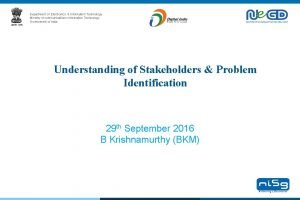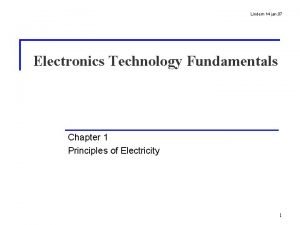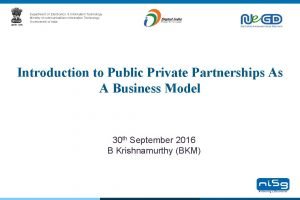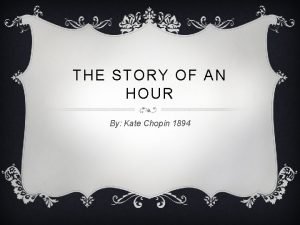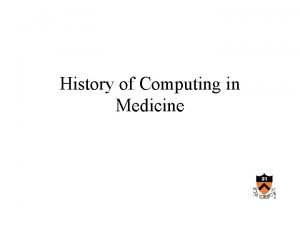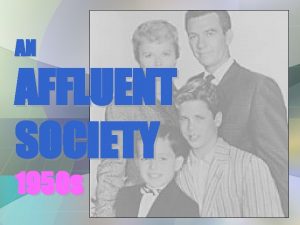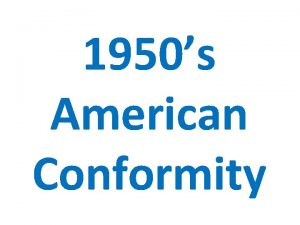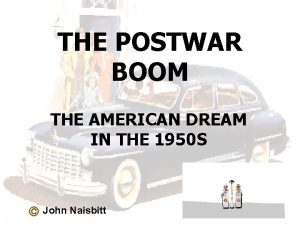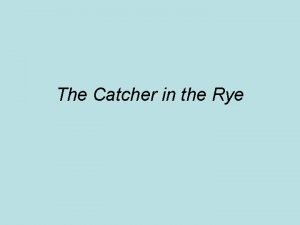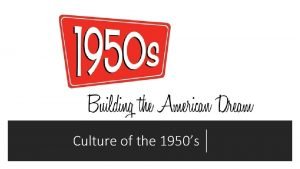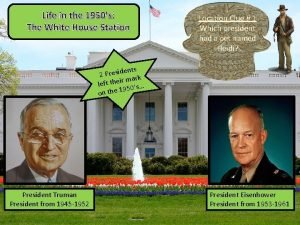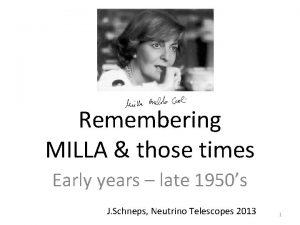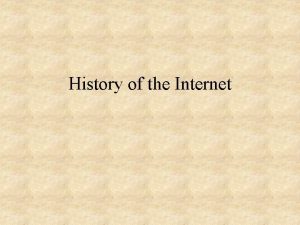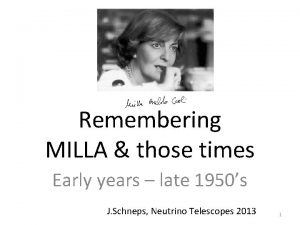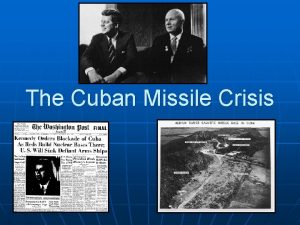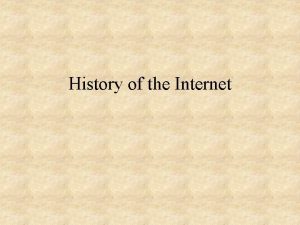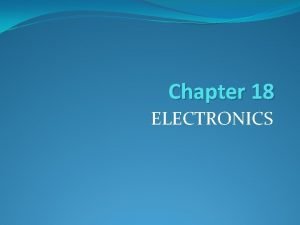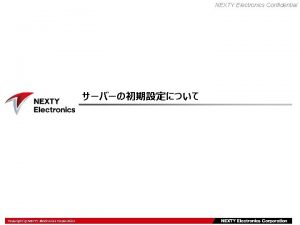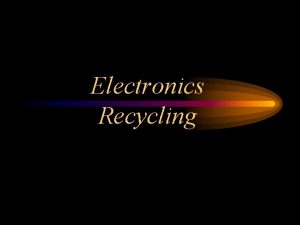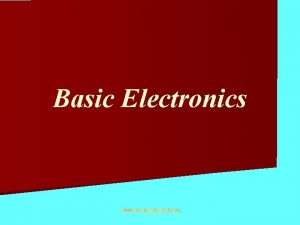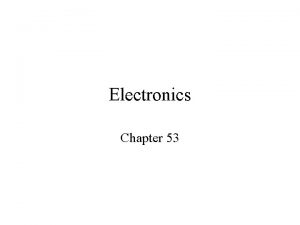Electronics Computing Technology of the mid 1950s late




















- Slides: 20

Electronics & Computing Technology of the mid 1950's – late 1960's The Apollo Vintage

EARLY TRANSISTOR TIMELINE 1925 Lilienfield - FET - Canadian Patent (Shockley/Pearson built a working FET copy in the 50's) 1947 Shockley team at BELL Experimental PNP Ge Point Contact Transistor 1948 (June) Shockley, BELL - US patent PNP Ge Point Contact Transistor 1948 (Aug) Matare', Westinghouse - French patent PNP Ge Point Contact Transistor 1951 Westinghouse - 1 st Limited Production PNP Ge Point Contact Transistor 1953 Raytheon - 1 st Low Cost Retail Production PNP Ge Junction Transistor 1954 – TI - First Commercial Silicon Transistors 1958/59 – First Logic IC - (TI Ge/Fairchild planar Si)

1954 – OC 71/72 10 k. Hz!

MULLARD 1954 -60 RANGE

1953 FIRST LOW COST PRODUCTION CK 722 Ge PNP Junction Transistor $7. 60

TI 1960 Si TRANSISTORS

TI 1960 Si PRODUCT RANGE

TI FIRST IC SN 514 DUAL 3 -INPUT NOR

TI SN 514 INTEGRATED CIRCUIT

Apollo GUIDANCE (NAV) COMPUTER (2 used on Apollo 11 Moon Landing, 1 in CM, 1 in LM) 1 cubic ft, 70 Watts at 24 V, 1 MHz clock panels) (plus multiple control ROM 6 modules of fixed core rope 36 KW (72 k. B), 11. 72 u. S (85 k. Hz) RAM 1 segment of erasable core 2 k. W (32 kb), 11. 72 u. S (85 k. Hz) 16 -bit words data = (14+ 1 sign + 1 overflow) address = 12 bits (with bank switching) 16 I/O channels 2880 10 -pin flatpacks -> 5760 x 3 -input NAND/NOR, RTL/RCTL gates Set-up with 4 x 16 -bit main registers, Accumulator, Program Counter, Remainder Register and Product Register and 13 more Registers Mainly from Fairchild, some from TI (priced about $40 -> $10 ea). . [2016 inflation multiplier x 8] Good Reference <http: //history. nasa. gov/computers/Ch 2 -5. html>

FLATPACK NOR GATE ARRAY

FAIRCHILD 60's PLANAR Si TECHNOLOGY

12 NOR GATES → FULL ADDER Adds A and B and Carry In → Sum and Carry Out

D-TYPE FLIP-FLOP MADE FROM 6 NOR GATES

IC COSTS LATE 1959 - EARLY 1963

1955 -75 VINTAGE RAM – CORE MEMORY Magnetic-core memory was the predominant form of random-access computer memory (RAM) for 20 years between about 1955 and 1975. Such memory is often just called core memory, or, informally, core. Core uses tiny magnetic toroids (rings), the cores, through which wires are threaded to write and read information. Each core represents one bit of information. The cores can be magnetized in two different ways (clockwise or counterclockwise) and the bit stored in a core is zero or one depending on that core's magnetization direction. The wires are arranged to allow for an individual core to be set to either a one or a zero and for its magnetization to be changed by sending appropriate electric current pulses through selected wires. The process of reading the core causes the core to be reset to a zero, thus erasing it. This is called destructive readout. To read and retain the original stored data requires a read/re-write operating sequence. When not being read or written, the cores maintain the last value they had, even when power is turned off. This makes them nonvolatile. Using smaller cores and wires the memory density of core slowly increased, and by the late 1960 s a density of about 32 kilobits per cubic meter was typical. However, reaching this density required extremely careful manufacture, almost always carried out by hand in spite of repeated major efforts to automate the process. The cost declined over this period from about $1 per bit to about 1 cent per bit.

32 x 32 1024 bit CORE RAM

Apollo 32 x 32 bit RAM (FRONT & BACK)

Apollo ROPE ROM MODULE (1 toroidal core holds 1 bit) Core rope memory is a form of read-only-memory (ROM), first used in the 1960 s by early NASA Mars probes and then in the Apollo Guidance Computer designed and programmed by the MIT Instrumentation Lab and built by Raytheon. Contrary to ordinary coincident-current magnetic core memory, which was used for RAM at the time, the ferrite cores in a core rope are just used as transformers. The signal from a word line wire passing through a given core is coupled to the bit line wire and interpreted as a binary "one", while a word line wire that bypasses the core is not coupled to the bit line wire and is read as a "zero". In the AGC, up to 64 wires could be passed through a single core. Software written by MIT programmers was woven into core rope memory by female workers in factories. Some programmers nicknamed the finished product LOL memory, for Little Old Lady memory.

Apollo HAND WOVEN ROPE ROM ( As many as 64 wires through some cores!)
 Ministry of electronics and information technology
Ministry of electronics and information technology It department odisha
It department odisha Electronics technology fundamentals
Electronics technology fundamentals Department of electronics & information technology
Department of electronics & information technology Conventional computing and intelligent computing
Conventional computing and intelligent computing Mid del tech
Mid del tech 1950s home economics textbook
1950s home economics textbook 1950s computers
1950s computers Beaniks
Beaniks Concept cars 1950s
Concept cars 1950s The affluent society 1950s
The affluent society 1950s 1950's music trivia questions and answers
1950's music trivia questions and answers Challenges to conformity in the 1950s
Challenges to conformity in the 1950s Suburban life 1950s
Suburban life 1950s 1950s conformity and counterculture
1950s conformity and counterculture Automania definition 1950
Automania definition 1950 Cost of living 1958
Cost of living 1958 1950s pop culture
1950s pop culture Mass media in the 1950s
Mass media in the 1950s What groups were experiencing poverty in the 1950’s?
What groups were experiencing poverty in the 1950’s? Beat writers 1950s
Beat writers 1950s
